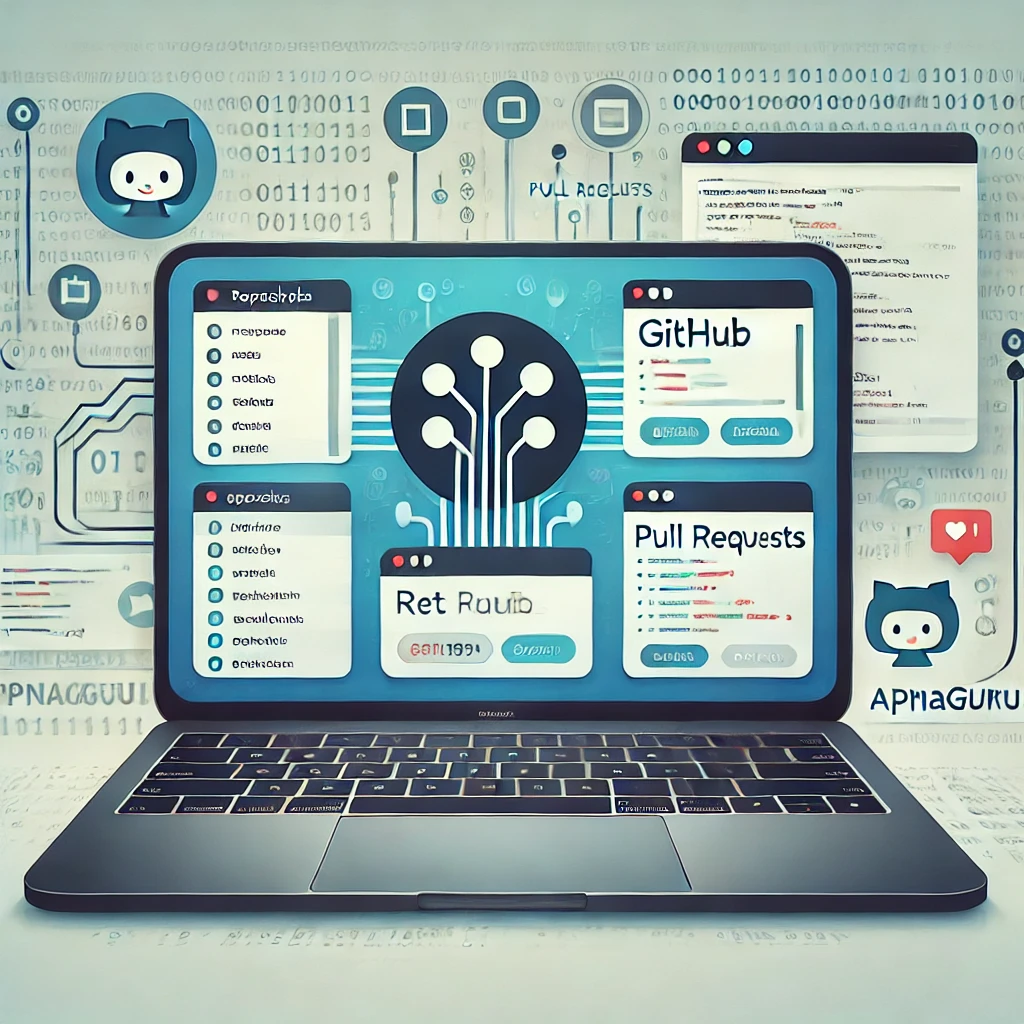
"From Zero to GitHub Hero: A Beginner's Journey with ApnaGuru"
Ever wondered how to share your coding masterpieces with the world or collaborate on exciting projects? Prepare to unlock the power of GitHub, the central hub for developers globally! This tutorial unravels the mystery, guiding you through each step of hosting your first project.
Understanding GitHub: A Beginner's Perspective
What is GitHub and Why Use It?
- GitHub is a web-based platform for hosting and managing code with version control, collaboration, and community features. It allows developers to track changes, collaborate seamlessly, and contribute to open-source projects.
- For developers at ApnaGuru, GitHub is an essential tool for showcasing skills, managing projects efficiently, and fostering teamwork. Its ability to track changes and enable multiple developers to work on the same project without conflicts makes it indispensable for professional and open-source growth.
- By integrating GitHub into workflows, ApnaGuru professionals can streamline their processes, deliver quality solutions, and enhance their technical profiles.
Key GitHub Concepts: Repositories, Branches, and Pull Requests
- Before diving in, understanding core GitHub concepts is vital. A repository (or repo) is essentially a project's container, holding all the files and code. Imagine it as a folder storing everything related to your project. A branch is like creating a copy of your project to work on new features or bug fixes without impacting the main codebase. It allows for parallel development.
- A pull request (PR) is the mechanism for integrating changes from a branch back into the main repository. This allows for code review and ensures quality control. It's like sending your improved code for approval before it's merged into the main project, greatly enhancing teamwork and preventing major errors. This structured workflow makes GitHub an ideal platform for both individual and collaborative projects.
Setting up Your GitHub Account: A Step-by-Step Guide
- First, navigate to github.com and create a free account. Provide a valid email address and choose a secure password. Complete the profile information, including your name and a short bio. You can also customize your profile with a picture and a link to your website or portfolio. Setting up two-factor authentication (2FA) is also highly recommended to enhance security.
- Once your account is set up, you'll need to familiarize yourself with the interface. Spend time exploring the dashboard and understanding the various options available. GitHub offers a plethora of resources and tutorials to help you learn more about the platform and its functionalities, which are essential to understanding how to host and manage your projects.
Creating Your First Repository on GitHub
Types of Repositories: Public vs. Private
- When creating your repository, you'll have the option to make it public or private. Public repositories are visible to everyone on GitHub, allowing others to see, use, and contribute to your project. This is great for open-source projects and building your portfolio.
- Private repositories are only accessible to you and those you explicitly grant access to. This is ideal for proprietary projects or when you don't want your code to be publicly available. Consider factors like security, intellectual property, and community involvement when choosing the appropriate repository type.
Adding a README File: The Importance of Documentation :-
- A README file is crucial for any project, regardless of size or complexity. It's a plain text file that explains what your project does, how to use it, and any other relevant information. Think of it as the welcome guide for your project. A well-written README greatly enhances the usability and appeal of your project.
- The README file should clearly outline the project's purpose, installation instructions, usage examples, and contribution guidelines. It should be easily understandable, even for those unfamiliar with the project. Include screenshots or diagrams to further enhance understanding and make it attractive. Use markdown formatting to make it easily readable. A good README significantly improves the user experience.
Licensing Your Project: Choosing the Right License :-
- Choosing the right license for your project is a crucial step. The license defines how others can use, modify, and distribute your code. Popular choices include the MIT License, GPL License, and Apache License. Each license has its own terms and conditions, so choose one that aligns with your project's goals and your own preferences.
- Researching different licenses will enable you to select the most appropriate one that aligns with the project's nature and its intended usage by others. Consider consulting legal counsel if you're uncertain about which license best suits your project to prevent any potential future issues relating to copyright or intellectual property.
Uploading Your Project to GitHub
Method 1: Using the GitHub Website :-
- GitHub provides a user-friendly interface to upload your project directly from your computer. Once you've created a repository, you'll find an option to upload files directly from your local system. Simply drag and drop your project files into the designated area. This method is simple and convenient, ideal for small projects.
- This method is particularly beneficial for beginners as it's intuitive and requires minimal technical expertise. After uploading the files, remember to commit and push your changes to finalize the upload and make your project accessible on the GitHub platform. Remember to double-check all files to ensure a complete upload.
Method 2: Using the Command Line Interface (CLI)
- For experienced developers or those comfortable using the command line, using Git CLI offers more control and flexibility. You can use commands like
git init,git add,git commit, andgit pushto manage your project directly from the terminal. This method is generally preferred for larger, more complex projects. - Using the command line offers granular control over every aspect of version control. It enables a deeper understanding of Git's functionalities and workflow. However, there's a steeper learning curve associated with this method, requiring familiarity with command-line interface usage. For those willing to invest the time, the command-line approach offers a powerful and efficient way to manage projects on GitHub.
Handling Large Files: Git LFS for Efficient Management
- Git is not optimally designed for handling very large files (images, videos, etc.). Git Large File Storage (LFS) is a solution to this. It replaces large files in your repository with text pointers, keeping your repository size manageable while still storing the actual files elsewhere. This approach enhances efficiency and reduces storage space.
- Integrating Git LFS involves installing the tool and then configuring it to manage specific file types within your repository. This way, you can continue to use Git's functionalities for version control without being hindered by the size of the files. For projects containing large media files, LFS is an essential tool for efficient project management on GitHub.
Managing Your Project on GitHub
Making Changes and Committing Updates
- Once your project is on GitHub, you can continue to make changes and upload updates. After making modifications to your code, you'll need to commit these changes using Git. A commit is a snapshot of your project at a specific point in time, capturing every change you've made. This is the core of version control.
- Each commit should have a clear and concise message explaining the changes made. This will allow you to easily track the changes over time and understand the evolution of your project. Regular commits are essential to maintain a well-organized project history, making it easier to trace changes and troubleshoot any issues.
Branching and Merging: Collaborative Development
- Branching is a crucial aspect of collaborative development on GitHub. Creating a new branch allows you to work on new features or bug fixes in isolation without affecting the main codebase. This ensures stability and allows multiple developers to work simultaneously without conflicts.
- Once changes are made on a branch, merging it back into the main branch integrates the new code. This process often involves code review to ensure quality and avoid introducing bugs. Proper branching strategies are fundamental for efficient and conflict-free collaborative development.
Pull Requests: Reviewing and Integrating Code
- Pull requests (PRs) are the mechanism for reviewing and integrating code changes from a branch into the main branch. They facilitate collaborative code review, allowing others to examine your changes before they are merged. This helps catch errors and improve code quality.
- PRs also provide a platform for discussion and collaboration. Team members can provide feedback, suggest improvements, and ensure the code meets the project's standards before being merged. This collaborative review process is a cornerstone of high-quality software development.
Issues and Project Management Tools
- GitHub provides issue tracking to manage tasks, bugs, and feature requests. Issues act as a central hub for discussing and tracking the progress of different aspects of your project. You can assign issues to team members, set deadlines, and track their status.
- GitHub also integrates with various project management tools, extending its capabilities. This allows for seamless integration of tasks and workflows, improving overall project efficiency. These features improve transparency and accountability within development teams.
Collaboration and Beyond
Working with Others on GitHub
- GitHub's strength lies in its ability to facilitate collaboration. You can easily invite others to contribute to your project, assigning roles and permissions as needed. This allows for a shared development environment, enabling teamwork on a global scale.
- Through features like pull requests, issue tracking, and team management, GitHub streamlines the collaborative workflow. This collaborative approach significantly boosts the development process, enabling faster progress and higher-quality code. GitHub truly transforms individual development into a shared endeavor.
